
At the Wine Bank: a map of Italy’s most important varietals and their regions
The Piemonte region is an area in northwestern Italy, bordering France and Switzerland, with distinct seasons and mountainous terrain (literally: “foot of the mountain”). It is considered one of the greatest winemaking regions in Italy, renowned for its Barolo and Barbaresco red wines made from Nebbiolo grapes.
For the first day of the Piedmont stage, we stopped by the Banca del Vino (wine bank) housed inside the Agenzia di Pollenzo, which is also home to (you guessed it) the University of Gastronomic Sciences. Ah, familiar stomping grounds. Inspired by a vision from Carlo Petrini, the Banca del Vino is an effort to build a historical record of Italian wines, to select, stock and maintain the best of the Italian peninsula. Thus, the vault is part storage cellar, part museum, and holds a collection of wines from over 300 producers across Italy while providing tastings for visitors. They also offer themed workshops if you are interested in researching one region or varietal in particular. Outside of the vault, a large number of wines line the shelves and are available for sale. I was amused to see one labeled “Cornell,” although additional research suggests that the wine has nothing to do with my alma mater or Ezra Cornell’s descendants.
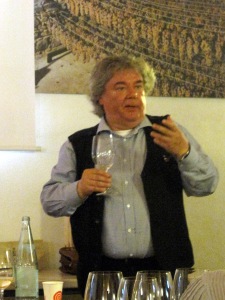
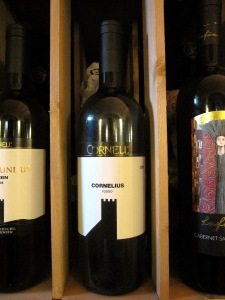
Our afternoon lecture was led by Vittorio Manganelli (above: left), manager of the Wine Bank, and Carlo Catani, director of the University. They gave us a talk on the history of winemaking and important milestones along the way to modern oenology (invention of the wine bottle, pasteurization). Vittorio was a jocular character as he guided us through a tasting of four wines. We tried a 2004 Langhe Bianco from Ettore Germano and Vittorio commented, “Sometimes people say they smell daisies. I mean I tell them, sure, why not. But this wine here smells a little bit like oil. That’s realistic, not an invention.” The next wine was a 2004 Le Zalte Cabernet from Cascina La Pertica. Vittorio wrinkled his brow as he announced, “I would say this smells like dead rat.” He proceeded to experiment with sipping the wine with his nose pinched.
Ultimately, I wasn’t impressed with any of the wines that we sampled, and was left wondering why they had selected these for our tasting. On the other hand, I guess it is good to try bad wines every now and then so that you know what they’re like and how to avoid them?
Moving on to the vaults, the Wine Bank includes over 2,000 square feet of cellar space, filled with boxes of wines organized by region and varietal. There are more red wines than whites because reds are more suitable for long periods of aging. For instance, the Wine Bank holds no moscato because it is not able to age. Vittorio exclaimed, “You know, like George Clooney: no martini, no party!”
The Wine Bank facilities are quite modern, though they are housed in the Agenzia di Pollenzo, a castle built in the mid 19th century. Like many buildings in Italy though, the new construction took place over and around old Roman ruins, which Vittorio hastened to point out to us. “For the Americans!”
For our next winery, we toured the cellars of Castello di Verduno. This is a small winery housed in another one of King Carlo Alberto di Savoia‘s castles, this one constructed in the 16th century, and it was here that modern Barolo was invented.. As our guide explained, Barolo is popularly known today as the King of Wines because at the time it was the wine of the King.
The building was purchased in 1909 by the Burlotto family, who restored and converted the wine cellar into a productive facility. Today, it is on its fourth generation of ownership, and notably is run almost exclusively by women.
We ventured down into the cellar, which was dark, dusty and looked like it could have been out of a scene from Poe’s Cask of Amontillado. Fortunately, I heard no persistent banging or screams for help. Wines are stored on racks with chalkboard signs, and I briefly wondered what would happen if some of them accidentally got erased. An old wooden crushing barrel and other winemaking antiques stood in the corner. Faded, peeling labels marked some of the bottles, but most were blank, since it’d be a waste of time to label and then relabel bottles after a decade in storage.
Disappointingly, once we got back upstairs, we were only offered one wine to sample, a 2008 Verduno Basadone. While this was quite good for a young wine, after seeing all the other products they had available, being offered one tasting was a bit of a letdown. I don’t know if the winery didn’t want to offer us more samples due to cost or because they weren’t prepared, but it certainly felt like they weren’t really trying.
Note to future UNISG winery hosts: if you don’t pull out the stops, you are only hurting yourself because we will happily buy 40 bottles of wine from you if we can sample your products.

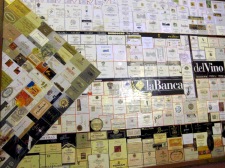


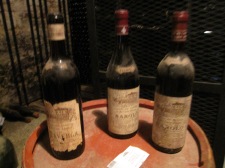
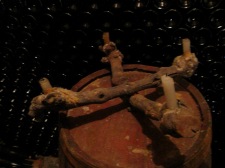
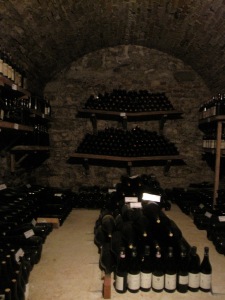
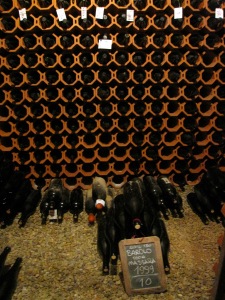
I totally quote the last sentence… They don’t know really much about marketing, do they? 😀
Oh. My. God. That entire map is done in Papyrus. I am offended.
I would sample Cornell, the Wine.
Maybe they know about as much about marketing as Maglio knows about communications?
Oh my god, it is entirely in Papyrus. In between the ‘dead rat’ wine and the map, I am now convinced that they were trying to troll us the entire time.